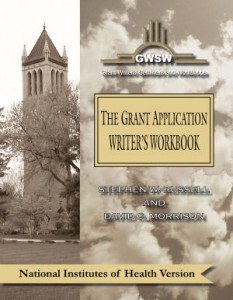As we warned NIH applicants in several earlier Facebook and blog posts (March 13 and 18, 2016), on March 25, 2016, the NIH published its ‘improved’ version of the Instructions for writing and submitting a grant proposal. In this publication is included the complete set of instructions that incorporates all of the new changes for the preparation of grant proposals to the NIH. In spite of the fact that the NIH website refers to the Application Guide, the instructions are no longer titled that way, with the exception of the general instructions. There are, in fact, now seven different iterations of the instructions – one general and six for specific grant mechanisms. For example, the one that applicants will use to apply for a Research Program Grant is titled, “Research Instructions for NIH and Other PHS Agencies”. The one for general instructions is titled “General Application Guide for NIH and Other PHS Agencies”. The other five that are specific are variations on that title, substituting “Training”, for example, for “Research”. These new requirements will become effective on May 25, 2016 and thereafter.
The new set of requirements codifies a significant number of changes in how applicants will need to write grant proposals to NIH in order to be in full compliance with all of the recently-implemented and yet to be implemented significant changes. These include five key areas that will need to be addressed by applicants:
1) significantly increased emphasis on the collective underlying research findings that provide the scientific premise of the proposed research;
2) significantly increased attention to rigorous experimental design;
3) careful consideration of sex and other relevant biological variables that could have an important impact on any research conclusions reached;
4) documented authentication of any key biological and/or chemical resources to be used in the proposed research; and
5) a formal methodology by which an applicant can recommend/exclude assignment to a specific NIH Institute/Center and or IRG/Study Section. See: http://grants.nih.gov/grants/how-to-apply-application-guide.htm
A key point with respect to these forthcoming important changes is that, for many of these, both new and experienced NIH applicants are likely to have considerable anxiety. Of importance, in this respect, the ‘how-to’ parts of the instructions are not specifically spelled out in this new and, presumably “helpful” updated document. There are well spelled-out new requirements, but relatively little about how to best to comply with them. As a consequence, it seems that applicants will be pretty much left to their own devices as to exactly how to proceed in the preparation of their applications. Moreover, while NIH Study Section members and ad hoc reviewers will likely receive some instructions from the NIH as to what to look for in reviewing proposals, it is our suspicion that many reviewers will not be in a significantly better position than their applicant peers.
As a second important point, it is highly likely that these new instructions, which are purported by the NIH to be “simplified and made easier”, compared to the ones that they replaced may not, in reality, achieve that objective.
While it is true that the new format, in some respects, is easier to understand (each requirement is listed as a separate bullet, rather than assembled in a narrative), there is an extensive use of hyperlinks directing the reader from the instructions to individual (and often more than one) NIH websites. That means that an applicant wanting to understand how to write/his/her application will be required to leave the online instructions to acquire the additional information. In other words, there is no single document that contains all of the instructions – unless the applicant would print all of the web-related information that has been provided to complement and extend the newly published Research Instructions for NIH and Other PHS Agencies. NIH applicants might note that the NIH detailed instructions to applicants contrasts rather significantly with other Federal Funding Agencies, who also award competitive grants; e.g NSF “Proposal and Procedures Guide”, (www.nsf.gov/pubs/policydocs/pappguide/nsf16001/gpg_index.jsp), the NASA (NRA and CAN) Guidebook for Proposers, (http://www.hq.nasa.gov/office/procurement/nraguidebook/proposer2016.pdf), or the Institute for Educational Sciences (http://ies.ed.gov/funding/pdf/2015_84305A.pdf), where updates and specific guidelines are available annually in user-friendly HTML or PDF printable formats.
To address this problem, our organization, GWSW has, for more than 15 years, made available to the NIH proposal-writing community, The Grant Application Writer’s Workbook (NIH version). We are currently finalizing the 2016 edition of this workbook, which will reflect these new changes and which we expect to have available toward the end of April, prior to the implementation of these new application changes on May 25, 2016. This should be well in time for applicants who plan to submit new applications to the NIH beginning with the forthcoming June deadline for applications.

